Cobbler’s pegs, Spanish needles
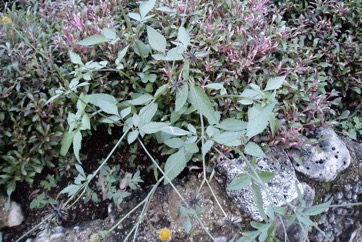
It grows in tropical rainforest areas. It grows on many different soil types. It grows from near sea level to over 2000 m altitude. It suits humid locations. It needs plenty of moisture and is not drought tolerant. Very common and widely distributed from northern Luzon to southern Mindanao in the Philippines. It occurs and is widely used throughout Malawi. It can grow in arid places. In Sichuan and Yunnan.
Also known as:
Abulesega, Aceitilla, Amor seco, Anantsinahibavy, Anyegomo, Ayegomon, Beggar's ticks, Bilodra, Black jack, Boboyo, Botongatonga, Burr marigold, Cadvolo, Chananguno, Chanonga, Chinomba, Chiseyo, Chisokono, Chisosoci, Choheke, Chuchuza, Daomeoai, Daun roten, Deumeubai, Djamwounkpi, Dong ma zhan, 'enwad, Enbureymaa, Enyikibon, Hei ni zuo ge mo, Hirikulha, Ilenjane, Inongwe, Itongatonga, Jarongan, Jerambing, Jongae, Junqqu, Kabata, Kaella, Kakala, Kaliputi, Kamalara, Kanzota, Kapuninga, Karay, Kashisha, Katarey kuro, Keroten, Ketul, Kimana-ngasi, Koheriki, Kuro, Lopalopa, Lungelima, Maina sag, Mayna arxa, Mbelembele, Mbwembwe, Mhuu, Mokolonyane, Monyana, Moonyane, Mozote, Mukkutthi, Mukongolo, Mushidzhi, Namulepo, Nat bar, Nihasha, Nsolokoto, Nyabarashana, Nyangudi, Nyanyiek-mon, Obukurra, Picao-preto, Picon, Puriket, Rhobashing, Rumput juala, Saetilla, Sere, Sheng-niangbaicuo, Sine, Solokoto, Ta-sae-ut, Tanggom oying, Teretani, Thole, Tsetsega, Tsine, Tukchong-muk, Tungunira, Ucucuza, Umahogo, Umhlabangubo, Uqadolo, X'tiyu, Ya dong long, Za qie mo, Zouqie
Synonyms
- Bidens abadiae DC.
- Bidens abadiae var. abadiae
- Bidens abadiae var. pilosoides Sherff
- Bidens adhaerescens Vell.
- Bidens africana Klatt
- Bidens alausensis Kunth
- Bidens alba (L.) DC.
- Bidens alba var. radiata (Sch.Bip.) Ballard ex Melchert
- Bidens arenaria Gand.
- Bidens arenicola Gand. [Invalid]
- Bidens aurantiaca Colenso
- Bidens barrancae M. E. Jones
- Bidens bimucronata Turcz.
- Bidens bonplandii Sch.Bip.
- Bidens brachycarpa DC.
- Bidens bullata var. glabrescens Fiori
- Bidens bullata var. hirta (Jord.) Coste
- Bidens calcicola Greenm.
- Bidens californica DC.
- Bidens cannabina Lam.
- Bidens caracasana DC.
- Bidens caucalidea DC.
- Bidens cernua var. anomala Farw.
- Bidens cernua var. tenuis Turcz. ex DC.
- Bidens chilensis DC.
- Bidens chilensis var. apiifolia DC.
- Bidens chilensis var. chilensis
- Bidens ciliata Hoffmanns. ex Fisch. & C. A. Mey.
- Bidens daucifolia DC.
- Bidens deamii Sherff
- Bidens decussata Pav. ex DC.
- Bidens decussata Pav. ex Steud.
- Bidens dichotoma Desf. ex DC.
- Bidens effusa Thuill. ex Sherff [Invalid]
- Bidens exaristata DC.
- Bidens fastigiata var. hispida Jord. ex Cariot & St.Lag. Bidens heterodoxa var. orthodoxa Fernald Bidens hirsuta Nutt. [Illegitimate] Bidens hirta Jord. Bidens hispida Kunth Bidens hybrida Thuill. Bidens inermis S. Watson
- Bidens leucantha (L.) Willd.
- Bidens leucantha Poepp. ex DC. [Illegitimate]
- Bidens leucantha var. leucantha
- Bidens leucantha var. pilosa (L.) Griseb.
- Bidens leucantha var. sundaica (Blume) Hassk.
- Bidens leucanthema f. discoidea Sch.Bip.
- Bidens leucanthema var. pilosa (L.) Griseb.
- Bidens leucanthema var. sundaica (Blume) Hassk.
- Bidens leucanthemus (L.) E. H. L. Krause
- Bidens minor (Wimm. & Grab.) Vorosch.
- Bidens minuscula H. Lév. & Vaniot
- Bidens montaubani Phil.
- Bidens odorata Cav.
- Bidens odorata var. calcicola (Greenm.) R.E.Ballard
- Bidens odorata var. oaxacensis Ballard
- Bidens orendainae M. E. Jones
- Bidens orientalis Velen. ex Bornm.
- Bidens paleacea Vis.
- Bidens pilosa f. alausensis (Kunth) Sherff
- Bidens pilosa var. albiflora Maxim.
- Bidens pilosa var. bimucronata (Turcz.) O.E.Schulz
- Bidens pilosa var. bimucronata (Turcz.) Sch.Bip.
- Bidens pilosa f. bimucronata (Turcz.) Sherff
- Bidens pilosa var. brachycarpa (DC.) O. E. Schulz
- Bidens pilosa var. brevifoliata Hieron.
- Bidens pilosa var. calcicola (Greenm.) Sherff
- Bidens pilosa f. calcicola (Greenm.) Sherff
- Bidens pilosa var. discoidea Sch.Bip.
- Bidens pilosa f. discoidea Sch.Bip. [Illegitimate]
- Bidens pilosa f. dissecta Sherff
- Bidens pilosa var. dubia (Cass.) O. E. Schulz
- Bidens pilosa var. humilis (Walp.) Walp. ex Reiche
- Bidens pilosa f. indivisa Sherff
- Bidens pilosa var. leucantha (L.) Harv.
- Bidens pilosa var. minor (Blume) Sherff
- Bidens pilosa f. monophylla (Urb.) Sherff
- Bidens pilosa f. odorata (Cav.) Sherff
- Bidens pilosa f. pilosa
- Bidens pilosa var. pilosa
- Bidens pilosa f. pilosior Kuntze
- Bidens pilosa f. pinnata Kuntze
- Bidens pilosa var. radiata (Sch.Bip.) Sherff
- Bidens pilosa var. radiata (Sch.Bip.) Sch.Bip. [Illegitimate]
- Bidens pilosa f. simplex Sherff
- Bidens pilosa f. subbiternatus Kuntze
- Bidens pilosa f. subsimplicifolia Kuntze
- Bidens pilosa f. ternata Kuntze
- Bidens pilosa f. triaristata Sherff
- Bidens pilosa f. umbrosa Sherff
- Bidens pinnata Noronha
- Bidens pumila (Retz.) Steud.
- Bidens ramosissima Sherff
- Bidens reflexa Link
- Bidens rosea Sch.Bip.
- Bidens rosea var. calcicola Greenm.
- Bidens scandicina Kunth
- Bidens striata Schott ex Sweet
- Bidens sundaica Blume
- Bidens sundaica var. minor Blume
- Bidens taquetii H. Lév. & Vaniot
- Bidens trifoliata Norona
- Bidens tripartita Bojer [Invalid]
- Bidens tripartita var. cannabina (Lam.) Beckh.
- Bidens tripartita var. discoidea Wimm.
- Bidens tripartita var. hirta (Jord.) Sherff
- Bidens tripartita var. hispida Cariot & St.-Lag.
- Bidens tripartita var. indivisa Corb.
- Bidens tripartita var. integra Peterm.
- Bidens tripartita var. integrifolia Wirtg.
- Bidens tripartita var. latifolia Rouy
- Bidens tripartita var. minima Lej.
- Bidens tripartita var. minor Wimm. & Grab.
- Bidens tripartita var. orientalis (Velen.) Sherff
- Bidens tripartita var. pumila Retz.
- Bidens tripartita var. radiata Wimm.
- Bidens tripartita var. tenuis (Turcz. ex DC.) DC.
- Bidens valparadisiaca Colla
- Bidens viciosoi Pau
- Bidens wallichii var. albiflora Max. ex Matsum.
- Ceratocephalus pilosus Rich. ex Cass.
- Coreopsis alba L.
- Coreopsis corymbifolia Buch.-Ham. ex DC.
- Coreopsis leucantha L.
- Coreopsis leucorrhiza Lour.
- Coreopsis multifida DC.
- Coreopsis multifida var. multifida
- Coreopsis multifida var. mutica DC.
- Coreopsis odorata Poir.
- Coreopsis odorata Lam.
- Glossogyne chinensis Less.
- Kerneria dubia Cass.
- Kerneria pilosa (L.) Lowe
- Kerneria pilosa var. pilosa
- Kerneria pilosa var. radiata (Sch.Bip.) Lowe
- Kerneria tetragona Moench [Illegitimate]
Edible Portion
- Leaves, Leaves - tea, Seeds, Flowers - tea, Vegetable
Where does Cobbler’s pegs grow?
Found in: Africa, America, American Samoa, Angola, Argentina, Asia, Australia, Azores, Bahamas, Belgium, Belize, Benin, Bermuda, Bhutan, Bolivia, Botswana, Brazil, Britain, British Indian Ocean Terr., BIOT, Burkina Faso, Burundi, Cameroon, Canada, Canary Island, Cape Verde, Central Africa, Central African Republic, CAR, Central America, Chad, Chile, China, Colombia, Comoros, Congo DR, Costa Rica, Côte d'Ivoire, Cuba, Dominica, Dominican Republic, East Africa, East Timor, Easter Island, Ecuador, Egypt, Equatorial-Guinea, Eritrea, Eswatini, Ethiopia, Fiji, Gabon, Gambia, Germany, Ghana, Guadeloupe, Guatemala, Guiana, Guianas, Guinea, Guinée, Guinea-Bissau, Guyana, Haiti, Hawaii, Himalayas, Honduras, India, Indochina, Indonesia, Ivory Coast, Jamaica, Japan, Kenya, Kiribati, Korea, Laos, Lesotho, Liberia, Madagascar, Malawi, Malaysia, Maldives, Mali, Marquesas, Martinique, Mauritania, Mauritius, Mexico, Mozambique, Myanmar, Namibia, Nauru, Nepal, New Zealand, Nicaragua, Niger, Nigeria, Norfolk Island, North Africa, North America, Northeastern India, Oman, Pacific, Panama, Papua New Guinea, PNG, Paraguay, Peru, Philippines, Puerto Rico, Rotuma, Rwanda, Sao Tome and Principe, Sao Tome and Principe, SE Asia, Senegal, Seychelles, Sierra Leone, Sikkim, Socotra, Somalia, South Africa, Southern Africa, South America, Spain, Sri Lanka, St Helena, St Lucia, Sudan, Suriname, Swaziland, Taiwan, Tanzania, Thailand, Tibet, Timor-Leste, Togo, Tonga, Trinidad-Tobago, Uganda, Uruguay, United States, Venezuela, Vietnam, West Africa, West Indies, Yemen, Zambia, Zimbabwe
Notes: This plant has been used in medicine and recent studies have shown these treatments are due to chemicals effective in controlling bacteria (gram positive types) and assisting liver function. Leaves are a good source of iodine. There are about 200 Bidens species. Most are in North America.
Status: It is a commercially cultivated vegetable. This plant is a troublesome weed in many places. It is only a very minor food in Papua New Guinea. It is both grown and eaten in Africa. It is widely used throughout Malawi and Zimbabwe. It is sold in local markets in China.
Growing Cobbler’s pegs, Spanish needles
Cultivation: Plants grow from seed. Seed need light and good aeration for them to grow. Seeds can become dormant and last for many years but will still grow. Good manuring of soils gives better leaf yields. A spacing of 15 cm between plants is suitable.
Edible Uses: The seeds are used in making an Igorot rice wine called "sinitsit" in the Philippines. The seeds are eaten, particularly by children (e.g. in Enga) in Papua New Guinea. The young leaves are edible cooked. They should be cooked due to saponins. The leaves are cooked in soups and stews. The young leaves can be dried for later use. Fresh they can only be stored for 3-4 days. The flowers are also used as a substitute for tea.
Production: It grows quickly. First leaves can be harvested 6 weeks after planting. Plants can be harvested for leaves 4-6 times over a 5-7 week period. Seed are produced 8-10 weeks after planting. Yields of leaves of 2 kg per metre square are possible.
Nutrition Info
per 100g edible portion| Edible Part | Energy (kcal) | Protein (g) | Iron (mg) | Vitamin A (ug) | Vitamin c (mg) | Zinc (mg) | % Water |
|---|---|---|---|---|---|---|---|
| Leaves | 57 | 4.1 | - | - | 50 | - | 82 |
| Seeds | - | - | - | - | - | - |
Cobbler’s pegs, Spanish needles Photos

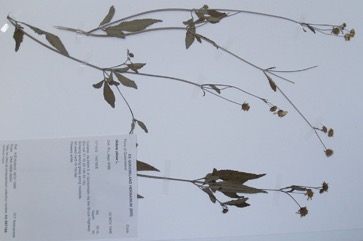
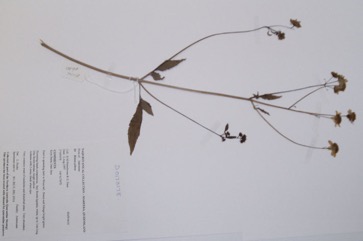
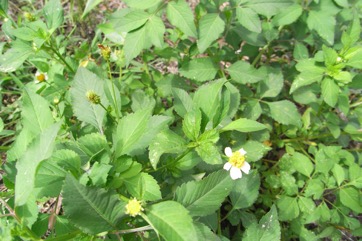
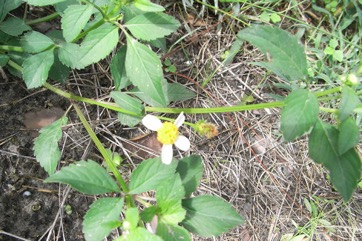
References
Abbiw, D.K., 1990, Useful Plants of Ghana. West African uses of wild and cultivated plants. Intermediate Technology Publications and the Royal Botanic Gardens, Kew. p 41
Achigan-Dako, E, et al (Eds), 2009, Catalogue of Traditional Vegetables in Benin. International Foundation for Science.
Agea, J. G., et al 2011, Wild and Semi-wild Food Plants of Bunyoro-Kitara Kingdom of Uganda: etc. Environmental Research Journal 5(2) 74-86
Altschul, S.V.R., 1973, Drugs and Foods from Little-known Plants. Notes in Harvard University Herbaria. Harvard Univ. Press. Massachusetts. no. 4871 (As Bidens pilosa var. bimucronata f odorata)
Anywar, G., et al, 2014, Wild Plants Used as Nutraceuticals from Nebbi District, Uganda. European Journal of medicinal Plants. 4(6):641-660
Asfaw, Z. and Tadesse, M., 2001, Prospects for Sustainable Use and Development of Wild Food Plants in Ethiopia. Economic Botany, Vol. 55, No. 1, pp. 47-62
Ambasta S.P. (Ed.), 2000, The Useful Plants of India. CSIR India. p 73
Awas, T., 1997, A Study on the Ecology and Ethnobotany of Non-cultivated Food Plants and Wild Relatives of Cultivated crops in Gambella Region, Southwestern Ethiopia. Addis Ababa University. p 41
Baro, D., Baruah, S. and Borthukar, S. K. 2015, Documentation on wild vegetables of Baksa district, BTAD (Assam). Scholars Research Library. Archives of Applied Science Research, 2015, 7 (9):19-27
Berihun, T. & Molla, E., 2017, Study on the Diversity and Use of Wild Edible Plants in Bullen District Northwest Ethiopia. Hindawi Journal of Botany. Article ID 8383468
Bircher, A. G. & Bircher, W. H., 2000, Encyclopedia of Fruit Trees and Edible Flowering Plants in Egypt and the Subtropics. AUC Press. p 59
Bodkin, F., 1991, Encyclopedia Botanica. Cornstalk publishing, p 146
Bodner, C. C. and Gereau, R. E., 1988, A Contribution to Bontoc Ethnobotany. Economic Botany, 43(2): 307-369
Borrell, O.W., 1989, An Annotated Checklist of the Flora of Kairiru Island, New Guinea. Marcellin College, Victoria Australia. p 62, 180
Brown, W.H., 1920, Wild Food Plants of the Philippines. Bureau of Forestry Bulletin No. 21 Manila. p 152
Burkill, H. M., 1985, The useful plants of west tropical Africa, Vol. 1. Kew.
Burkill, I.H., 1966, A Dictionary of the Economic Products of the Malay Peninsula. Ministry of Agriculture and Cooperatives, Kuala Lumpur, Malaysia. Vol 1 (A-H) p 326
Bvenura, C. and Afolayan, A. J., 2017, Tackling food and nutrition insecurity using leafy wild vegetables: The nutritional compositions of some selected species.
Cao, Y., et al, 2020, Ethnobotanical study on wild edible plants used by three trans-boundary ethnic groups in Jiangcheng County, Pu’er, Southwest China. Journal of Ethnobiology and Ethnomedicine (2020) 16:66
Carretero, A. L., 2005, Useful Plants and traditional knowledge in the Tucumano-Boliviano Forest. M. Sc. Thesis Institute of Biological Science University of Aarhus, Denmark p 52
Codjia, J. T. C., et al, 2003, Diversity and local valorisation of vegetal edible products in Benin. Cahiers Agricultures 12:1-12
Cooper, W. and Cooper, W., 2004, Fruits of the Australian Tropical Rainforest. Nokomis Editions, Victoria, Australia. p 79
Cribb, A.B. & J.W., 1976, Wild Food in Australia, Fontana. p 116
Crowe, A., 1997, A Field Guide to the Native Edible Plants of New Zealand. Penguin. p 156
Dangol, D. R. et al, 2017, Wild Edible Plants in Nepal. Proceedings of 2nd National Workshop on CUAOGR, 2017.
Dansi, A., et al, 2008, Traditional leafy vegetables and their use in the Benin Republic. Genet Resour Crop Evol (2008) 55:1239–1256
Dansi, A., et al, 2012, Diversity of the Neglected and Underutilized Crop Species of Importance in Benin. The Scientific World Journal. Volume 2012, Article ID 932947, 19 pages
Diaz-Betancourt, M., et al, 1999, Weeds as a future source for human consumption. Rev. Biol. Trop. 47(3):329-338 (As Bidens odorata)
Dutta, U., 2012, Wild Vegetables collected by the local communities from the Churang reserve of BTD, Assam. International Journal of Science and Advanced Technology. Vol. 2(4) p 119
Ekman Herbarium records Haiti
Epenhuijsen C.W. van., 1974, Growing Native vegetables in Nigeria. FAO Rome, p 38
Facciola, S., 1998, Cornucopia 2: a Source Book of Edible Plants. Kampong Publications, p 34
FAO, 1988, Traditional Food Plants, FAO Food and Nutrition Paper 42. FAO Rome p 104
Flora of Australia Volume 49, Oceanic Islands 1, Australian Government Publishing Service, Canberra. (1994) p 399
Fowler, D. G., 2007, Zambian Plants: Their Vernacular Names and Uses. Kew. p 12
Fox, F. W. & Young, M. E. N., 1982, Food from the Veld. Delta Books. p 120
Franklin, J., Keppel, G., & Whistler, W., 2008, The vegetation and flora of Lakeba, Nayau and Aiwa Islands, Central Lau Group, Fiji. Micronesica 40(1/2): 169–225, 2008
French, B.R., 1986, Food Plants of Papua New Guinea, A Compendium. Asia Pacific Science Foundation p 317
Ghorbani, A., et al, 2012, A comparison of the wild food plant use knowledge of ethnic minorities in Naban River Watershed Nature Reserve, Yunnan, SW China. Journal of Ethnobiology and Ethnomedicine; 8:17
Godfrey, J. et al, 2013, Harvesting, preparationand preservation of commonly consumed wild and semi-wild food plants in Bunyoro-Kitara Kingdom, Uganda. Int. J. Med. Arom. Plants. Vol.3 No.2 pp 262-282
Goode, P., 1989, Edible Plants of Uganda. FAO p 39
Goode, P., 1989, Edible Plants of Uganda. FAO p 26
Goode, P., 1989, Edible Plants of Uganda. FAO p 41
Grubben, G. J. H. and Denton, O. A. (eds), 2004, Plant Resources of Tropical Africa 2. Vegetables. PROTA, Wageningen, Netherlands. p 114
Guil-Guerrero, J. L., et al, 2001, Edible Wild Plants. in Recent Progress in Medicinal Plants Vol. 8 Sci. Tech publishing, Texas
Haberle, S., 2005, Ethnobotany of the Tari basin, Southern Highlands Province, Papua New Guinea. Palaeoworks Technical Paper 6.
Hani Medicine of Xishuangbanna, 1999, p 187
Hariyadi, B., 2008, The Entwined Tree: Traditional Natural Resource Management of Serampas, Jambi, Indonesia. Ph. D thesis. Univ. or Hawaii. p 401
Harkonen, M. & Vainio-Mattila, K., 1998, Some examples of Natural Products in the Eastern Arc Mountains. Journal of East African Natural History 87:265-278
Henty, E.E., & Pritchard, G.S., 1973, Weeds of New Guinea and their control. Botany Bulletin No 7, Division of Botany, Lae, PNG. p 67
Hussey, B.M.J., Keighery, G.J., Cousens, R.D., Dodd, J., Lloyd, S.G., 1997, Western Weeds. A guide to the weeds of Western Australia. Plant Protection Society of Western Australia. p 90
Jardin, C., 1970, List of Foods Used In Africa, FAO Nutrition Information Document Series No 2.p 59 (Also as Bidens leucantha)
Johns, T., and Kokwaro, J.O., 1991, Food Plants of the Luo of Siayo District, Kenya. Economic Botany 45(1), pp 103-113
Joshi, N., et al, 2007, Traditional neglected vegetables of Nepal: Their sustainable utilization for meeting human needs. Tropentag 2007. Conference on International Agricultural Research for Development.
Joshi, N. & Siwakoti, M., 2012, Wild Vegetables Used by Local Community of Makawanpur District and Their Contribution to Food Security and Income Generation. Nepal Journal of Science and Technology Vol. 13, No. 1 (2012) 59-66
Kays, S. J., and Dias, J. C. S., 1995, Common Names of Commercially Cultivated Vegetables of the World in 15 languages. Economic Botany, Vol. 49, No. 2, pp. 115-152
Kebebew, M. & Leta, G., 2016, Wild Edible Plant Bio-diversity and Utilization System in Nech Sar National Park, Ethiopia. International Journal of Bio-resource and Stress Management 2016, 7(4):885-896
Kepe, T., 2008, Social Dynamics of the Value of Wild Edible Leaves (Imifino) in a South African Rural Area. Ecology of Food and Nutrition, 47:531-558
Kinupp, V. F., 2007, Plantas alimenticias nao-convencionais da regiao metropolitana de Porto Alegre, RS, Brazil p 65
Kinupp, V. F. & Bergman, I., 2008, Protein and minerals of native species, potential vegetables and fruits. Cienc.Tecnol. Aliment. Vol. 28 No. 4 Campinas Oct/Dec.
Krishna, B., & Singh, S., 1987, Ethnobotanical Observations in Sikkim. J. Econ. Tax. Bot. Vol. 9 No. 1 pp 1-7
Lamp, C & Collet F., 1989, Field Guide to Weeds in Australia. Inkata Press. p 36
Latham, P., 2004, Useful Plants of Bas-Congo province. Latham & DFID p 50
Latham, P. & Mbuta, A. K., 2014, Useful Plants of Bas-Congo Province, Democratic Republic of Congo. Volume 1. Salvation Army. p 76
Lautenschläger, T., et al, 2018, First large-scale ethnobotanical survey in the province of Uíge, northern Angola. Journal of Ethnobiology and Ethnomedicine (2018) 14:51
Lazarides, M. & Hince, B., 1993, Handbook of Economic Plants of Australia, CSIRO. p 33
Li, D. et al, 2017, Ethnobotanical survey of herbal tea plants from the traditional markets in Chaoshan, China. Journal of Ethnopharmacology. 205 (2017) 195-206
Long, C., 2005, Swaziland's Flora - siSwati names and Uses http://www.sntc.org.sz/flora/
Luo, B., et al, 2019, Wild edible plants collected by Hani from terraced rice paddy agroecosystem in Honghe Prefecture, Yunnan, China. Journal of Ethnobiology and Ethnomedicine 15:56
Low, T., 1991, Wild Herbs of Australia and New Zealand. Angus & Robertson. p 72 (Drawing)
Low, T., 1992, Bush Tucker. Australia’s Wild Food Harvest. Angus & Robertson. p 154
Lulekal, E., et al, 2011, Wild edible plants in Ethiopia: a review on their potential to combat food insecurity. Afrika Focus - Vol. 24, No 2. pp 71-121
Lyimo, M., et al, 2003, Identification and nutrient composition of indigenous vegetables of Tanzania. Plant Foods for Human Nutrition. 58: 85-92
Magwede, K., van Wyk, B.-E., & van Wyk, A. E., 2019, An inventory of Vhavenḓa useful plants. South African Journal of Botany 122 (2019) 57–89
Malaisse, F., 1997, Se nourrir en floret claire africaine. Approche ecologique et nutritionnelle. CTA., p 59
Malezas Comestibles del Cono Sur, INTA, 2009, Buernos Aires
Manandhar, N.P., 2002, Plants and People of Nepal. Timber Press. Portland, Oregon. p 111
Marandi, R. R. & Britto, S. J., 2015, Medicinal Properties of Edible Weeds of Crop Fields and Wild plants Eaten by Oraon Tribals of Latehar District, Jharkhand. International Journal of Life Science and Pharma Research. Vo. 5. (2) April 2015
Martin, F.W. & Ruberte, R.M., 1979, Edible Leaves of the Tropics. Antillian College Press, Mayaguez, Puerto Rico. p 62, 106, 184 (Also as Bidens leucantha)
Masters, T., 2021, Traditional food plants of the upper Aswa River catchment of northern Uganda—a cultural crossroads. Journal of Ethnobiology and Ethnomedicine (2021) 17:24
Maundu, P. et al, 1999, Traditional Food Plants of Kenya. National Museum of Kenya. 288p
Melzer, R. & Plumb, J., 2011, Plants of Capricornia. Belgamba, Rockhampton. p 546
Molla, A., Ethiopian Plant Names. http://www.ethiopic.com/aplants.htm
Maroyi, A., 2011, The Gathering and Consumption of Wild Edible Plants in Nhema Communal Area, Midlands Province, Zimbabwe. Ecology of Food and Nutrition 50:6, 506-525
Maroyi, A., 2013, Use of weeds as traditional vegetables in Shurugwi District, Zimbabwe. Journal of Ethnobiology and Ethnomedicine 9:60
Msola, D. K., 2007, The role of Wild Foods in Household Income and Food Security in Mufundi District, Tanzania. Morogoro, Tanzania. p 46
Mot So Rau Dai an Duoc O Vietnam. Wild edible Vegetables. Ha Noi 1994, p 76
Msuya, T. S., et al, 2010, Availability, Preference and Consumption of Indigenous Foods in the Eastern Arc Mountains, Tanzania, Ecology of Food and Nutrition, 49:3, 208-227
Mukhia, P.K., et al, 2013, Wild plants as Non Wood Forest Products used by the rural community of Dagana, a southern foothill district of Bhutan, SAARC Journal, 27 pages
Mvere, B., 2004. Bidens pilosa L. [Internet] Record from Protabase. Grubben, G.J.H. & Denton, O.A. (Editors). PROTA (Plant Resources of Tropical Africa / Ressources végétales de l’Afrique tropicale), Wageningen, Netherlands. < http://database.prota.org/search.htm>. Accessed 14 October 2009.
Narzary, H., et al, 2013, Wild Edible Vegetables Consumed by Bodo tribe of Kokrajhar District (Assam), North-East India. Archives of Applied Science Research, 5(5): 182-190
Ochse, J.J. et al, 1931, Vegetables of the Dutch East Indies. Asher reprint. p 119
Ogle, B. M. & Grivetti, L. E., 1984, Legacy of the Chameleon: Edible Wild Plants in the Kingdom of Swaziland, Southern Africa. A Cultural, Nutritional Study. Part 4 - Nutritional Analysis and Conclusions. Ecology of Food and Nutrition. Vol 17, pp 431-64
Ojelel, S. & Kakudidi E. K., 2015, Wild edible plant species utilized by a subsistence farming community in the Obalanga sub-county, Amuria district, Uganda. Journal of Ethnobiology and Ethnomedicine. 11:7
Okigbo, B.N., Vegetables in Tropical Africa, in Opena, R.T. & Kyomo, M.L., 1990, Vegetable Research and development in SADCC countries. Asian Vegetable Research and development Centre. Taiwan. p 38
Patiri, B. & Borah, A., 2007, Wild Edible Plants of Assam. Geethaki Publishers. p 70
Peekel, P.G., 1984, (Translation E.E.Henty), Flora of the Bismarck Archipelago for Naturalists, Division of Botany, Lae, PNG. p 565, 564
Pena, F. B., et al, 1998, Los quelites de la Sierra Norte de Puebla, Mexico: Inventory Y Formas de Preparacion. Bol. Soc. Bot. Mexico 62:49-62 (As Bidens odorata)
Peters, C. R., O'Brien, E. M., and Drummond, R.B., 1992, Edible Wild plants of Sub-saharan Africa. Kew. p 88
Pickering, H., & Roe, E., 2009, Wild Flowers of the Victoria Falls Area. Helen Pickering, London. p 33
Plants for a Future database, The Field, Penpol, Lostwithiel, Cornwall, PL22 0NG, UK. http://www.scs.leeds.ac.uk/pfaf/
Plants of Haiti Smithsonian Institute http://botany.si.edu
Plowes, N. J. & Taylor, F. W., 1997, The Processing of Indigenous Fruits and other Wildfoods of Southern Africa. in Smartt, L. & Haq. (Eds) Domestication, Production and Utilization of New Crops. ICUC p 186
Polinag, M. A., 2003, Food from the Wilderness. Department of Environment and Natural Resources. Laguna.
Ramachandran,V. S., & Udhayavani, C., 2013, Knowledge and uses of wild edible plants by Paniyas and Kurumbas of Western Nilgiris, Tamil Nadu. Indian Journal of Natural Products and Resources. 4(4) December 2013, pp 412-418
Raponda-Walker, A & Sillans, R., 1961, Les Plantes Utiles du Gabon. Editions Paul Lechevalier, Paris. p 126
Recher, P, 2001, Fruit Spirit Botanical Gardens Plant Index. www.nrg.com.au/~recher/ seedlist.html p 1
Roodt, V., 1998, Common Wild Flowers of the Okavango Delta. Medicinal Uses and Nutritional value. The Shell Field Guide Series: Part 2. Shell Botswana. p 39
Royal Botanic Gardens, Kew (1999). Survey of Economic Plants for Arid and Semi-Arid Lands (SEPASAL) database. Published on the Internet; http://www.rbgkew.org.uk/ceb/sepasal/internet [Accessed 11th April 2011]
Rubaihayo, E. B., Conservation and use of traditional vegetables in Uganda. Bioversity International.
Ruffo, C. K., Birnie, A. & Tengnas, B., 2002, Edible Wild Plants of Tanzania. RELMA p 162
Ruiters-Welcome, A. K., 2019, Food plants of southern Africa. Ph.D. thesis. Univ. of Johannesburg p 33
Sarma, H., et al, 2010, Updated Estimates of Wild Edible and Threatened Plants of Assam: A Meta-analysis. International Journal of Botany 6(4): 414-423
Savita, et al, 2006, Studies on wild edible plants of ethnic people in east Sikkim. Asian J. of Bio Sci. (2006) Vol. 1 No. 2 : 117-125
Shava, S., 2000, The Use of Indigenous Plants as Food by a Rural Community in the Eastern Cape: an Educational Exploration. Masters Thesis Rhodes University. p 63
Shackleton, S. E., et al, 1998, Use and Trading of Wild Edible Herbs in the Central Lowveld Savanna Region, South Africa. Economic Botany, Vol. 52, No. 3, pp. 251-259
Shava, S., et al, 2009, Traditional food crops as a source of community resilience in Zimbabwe. International Journal of the African Renaissance 4(1)
Sp. pl. 2:832. 1753
Sujanapal, P., & Sankaran, K. V., 2016, Common Plants of Maldives. FAO & Kerala FRI, p 55
Swaziland's Flora Database http://www.sntc.org.sz/flora
Tanaka, Y. & Van Ke, N., 2007, Edible Wild Plants of Vietnam: The bountiful garden. Orchid books. p 38
Taram, M., et al, 2018, Wild Food Plant Resources of Komkar Adi Tribe of Upper Siang District in Arunachal Pradesh, India. Bulletin of Arunachal Forest Research, Vol. 33(2), 27-35
Terashima, H., et al, 1992, Ethnobotany of the Lega in the Tropical Rainforest of Eastern Zaire (Congo): Part Two, Zone de Walikale, African Study Monographs, Suppl. 19:1-60
Termote, C., et al, 2011, Eating from the wild: Turumbu, Mbole and Bali traditional knowledge of non-cultivated edible plants, District Tshopo, DRCongo, Gen Resourc Crop Evol. 58:585-618
Terra, G.J.A., 1973, Tropical Vegetables. Communication 54e Royal Tropical Institute, Amsterdam, p 29 (Also as Bidens leucantha)
Thoa, P. T. K., et al, 2013, Biodiversity indices and utilization of edible wild plants a case study of the Cham Island in Quang Nam Province, Vietnam. Journal of research in Environmental Science and Toxicology Vol. 2(9): 167-174
Topp, J. M. W., 1988, An Annotated Check List of the Flora of Diego Garcia, British Ocean Territory. Atoll Research Bulletin No. 313
Tredgold, M.H., 1986, Food Plants of Zimbabwe. Mambo Press. p 37
Tsering, J., et al, 2017, Ethnobotanical appraisal on wild edible plants used by the Monpa community of Arunchal Pradesh. Indian Journal of Traditional Knowledge. Vol 16(4), October 2017, pp 626-637
Vainio-Mattila, K., 2000, Wild vegetables used by the Sambaa in the Usumbara Mountains, NE Tanzania. Ann. Bot. Fennici 37:57-67
van Wyk, Be., & Gericke, N., 2007, People's plants. A Guide to Useful Plants of Southern Africa. Briza. p 68
Vernon, R., 1983, Field Guide to Important Arable Weeds of Zambia. Dept of Agriculture, Chilanga, Zambia. p 82
Wehmeyer, A. S, 1986, Edible Wild Plants of Southern Africa. Data on the Nutrient Contents of over 300 species.
Wheeler, J.R.(ed.), 1992, Flora of the Kimberley Region. CALM, Western Australian Herbarium, p 934
Williamson, J., 2005, Useful Plants of Malawi. 3rd. Edition. Mdadzi Book Trust. p 36
World Checklist of Useful Plant Species 2020. Royal Botanic Gardens, Kew
www.zimbabweflora.co.zw 2011
Xu, You-Kai, et al, 2004, Wild Vegetable Resources and Market Survey in Xishuangbanna, Southwest China. Economic Botany. 58(4): 647-667.
Yuncker, T.G., 1959, Plants of Tonga, Bernice P. Bishop Museum, Hawaii, Bulletin 220. p 269
Zizka, G., 1991, Flowering Plants of Easter Island. Palmarum Hortus Francofurtensis
Zon, A.P.M. van der, Grubben, G.J.H., 1976, Les legumes-feuilles spontanes et cultives du Sud-Dahomey, Communication 65, Royal Tropical Institute, Amsterdam, p 36